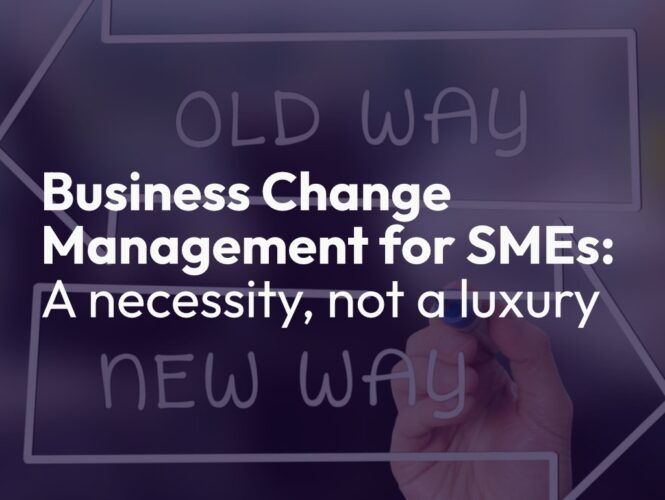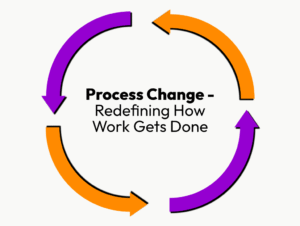In the rapidly evolving landscape of British business, small and medium enterprises (SMEs) face a unique paradox. They possess the agility that larger corporations envy, yet they often lack the resources to implement change as seamlessly as their bigger counterparts. When it comes to business change management, this disparity becomes particularly pronounced, yet the need for effective change management remains constant regardless of organisational size.
The Scale Challenge: Navigating Different Waters
For SMEs, change management isn’t simply a scaled-down version of what enterprise-level organisations do. The fundamental differences in structure, resources, and culture create entirely different challenges and opportunities. In a small business with 20 employees, every person represents 5% of the workforce. When that same percentage translates to 500 people in a large corporation, the human impact becomes dramatically different.
Small businesses operate with flatter hierarchies, often with the Managing Director rolling their sleeves up in daily activities. This proximity can be both a blessing and a curse. Whilst it enables rapid decision-making and direct communication, it also means that resistance to change can come from unexpected quarters, and the ripple effects of any transformation touch every corner of the organisation almost instantaneously.
Medium-sized enterprises, typically employing between 50-250 people, occupy a particularly challenging middle ground. They’re large enough to have developed some organisational complexity (perhaps departmental silos or management layers) but not large enough to have dedicated change savvy resources. They’ve outgrown the intimate, ‘everyone knows everyone’ culture of micro-businesses but haven’t yet reached the scale where formal change management processes become routine or I daresay, even thought about or considered.
Budget Realities: Making every penny count
The budget constraints facing SMEs are perhaps the most significant differentiator in change management provision. Where a multinational corporation might allocate millions to a digital transformation programme, including substantial change management support, an SME might be working with a budget that represents a significant portion of their annual turnover.
This reality often leads to a dangerous misconception: that change management is a luxury that smaller businesses cannot afford. In truth, the opposite is true. SMEs have less margin for error, fewer resources to recover from failed initiatives, and typically less organisational resilience to absorb the shock of poorly managed change. For these businesses, effective change management isn’t a nice-to-have, it’s a business-critical necessity that can mean the difference between thriving and merely surviving.
The ROI Imperative: Why change resourcing pays for itself
Think about the SME that invests £50,000 in a new CRM (Customer Relationship Management) system. Without proper adoption and change management, studies consistently show that 60-70% of such technology implementations fail to deliver their intended benefits. For an SME, this represents not just a financial loss but potentially a competitive disadvantage that could take years to overcome.
Conversely, when change is managed effectively, the return on investment accelerates dramatically. Employees adoption of new systems is expedited, productivity disruption (and sometimes complete crash) is minimised, and the business begins realising benefits sooner. In the SME context, where cash flow is often tight and every efficiency gain matters, this accelerated ROI can be transformational.
Structural Advantages: Turning size into strength
Despite the challenges, SMEs possess inherent advantages in change management that larger organisations would envy. Communication pathways are shorter, decision-making is faster, and the personal relationships between leadership and staff often create a foundation of trust that facilitates change adoption.
The key is recognising these advantages and building change management approaches that leverage them. Rather than attempting to replicate the formal, process-heavy approaches favoured by large corporations, SMEs can adopt more agile, relationship-based strategies that align with their organisational culture and resource constraints.
The Human-Centred Approach: Making change less scary
This is where the philosophy of putting people first becomes crucial. Change, by its very nature, creates uncertainty and anxiety. In smaller organisations, where job security might feel more precarious and where individual contributions are more visible, these concerns can be amplified.
Effective change management in the SME context requires a fundamentally human-centred approach. It’s about understanding that behind every resistance to change is a person with legitimate concerns; whether about job security, competence, or simply the comfort of familiar routines. By addressing these human factors first, the technical aspects of change become far more manageable.
The Good Change People Difference
Organisations like Good Change People understand that SMEs don’t need change management scaled down, they need change management re-imagined. They recognise that smaller businesses require partners who understand their unique challenges, budget constraints, and cultural dynamics. They know that change doesn’t have to be scary when it’s approached with empathy, clear communication, and genuine care for the people involved.
This approach acknowledges that whilst SMEs may not have the resources of large corporations, they often have something more valuable: the ability to be genuinely agile, to make decisions quickly, and to create authentic connections between leadership and staff. When change management leverages these strengths rather than viewing them as constraints, remarkable transformations become possible.
Conclusion: Change as a competitive advantage
For SMEs, the question isn’t whether they can afford change management, it’s whether they can afford not to invest in it. In an increasingly competitive marketplace, the ability to adapt quickly and effectively to new technologies, market conditions, and customer expectations isn’t just beneficial, it’s essential for survival.
The businesses that thrive will be those that recognise change management not as an expensive add-on to transformation initiatives, but as the foundation that ensures those initiatives deliver their promised value. By partnering with consultancies that understand the unique dynamics of smaller organisations and prioritise the human side of change, SMEs can turn their size from a perceived disadvantage into a genuine competitive advantage.
After all, in a world where change is the only constant, being good at change isn’t just about surviving; it’s about thriving.





